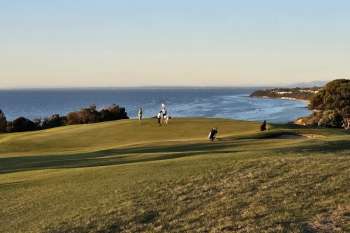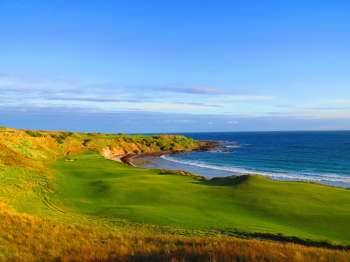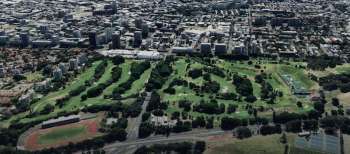In just two short months we here at Australian Golf Digest will be releasing our 2010 ranking of Australia’s Top 100 Courses, sure to again be one of our most anticipated and hot debated issues. Those who follow our biennial list closely will observe some important changes to this latest list, with the scraping of composite course rankings and the criteria for conditioning altered to focus more on the nature, rather than the colour, of the playing surfaces. Perhaps the most noticeable difference between the 2010 ranking and every other list published since 1998, however, will be the lack of a high-flying debutant.
Since our last ranking in 2008 there has been a sharp downturn in the world golf economy, particularly in established regions like the US, UK and Europe. In Australia the affects have certainly been felt, but construction continues and judges still have five new courses to consider for 2010. What’s different this year, however, is that all five candidates are from the one state, Victoria, and none have created anywhere near the level of buzz and anticipation seen with the modern creations preceding them.
Over the past decade or so some outstanding golf courses have opened in this country. In fact at least one debutant course from every ranking since 1998 features within our current Top 25. These include the Dunes (25), remodelled by Tony Cashmore prior to the 1998 ranking, Kennedy Bay (20), which debuted in 2000 and the Moonah Course at The National (8) from 2002. Following the 2004 appearance of Ellerston (4) and the Open Course at Moonah Links (17) came the arrival in 2006 of the world regarded and wonderful Barnbougle Dunes layout (now 5). Moonah Links Legends (14) and The Cut at Port Bouvard (16) in Western Australia also made the grade that year, while the highest-ranking newcomer in our last survey was Magenta Shores at number 24.
These are all significant golf courses, as are other high-profile modern tracks further down the list, such as Brookwater, St Andrews Beach, Thirteenth Beach, The Grand and The National (Ocean). Skimming through this honour roll one quickly appreciates that this really has been a golden era for new course construction in Australia.
With the imminent completion of the second course at Barnbougle Dunes and some exciting new projects underway at Greg Norman’s company, I’m not prepared to call an end to our golden golf renaissance just yet, but I am prepared to wager that for the first time in nearly a decade we won’t see a new course among Australia’s top 25 in 2010. There are myriad reasons for this, the most obvious being that none of the new candidates – Eynesbury, Forest Resort at Creswick, Sandhurst (Champions Course), Settler’s Run and Yering Meadows – are located near the sea or on the sort of land that yields really exciting golf. This isn’t to suggest they don’t have golfing appeal, however, and it wouldn’t surprise to see a number of these layouts featured somewhere among our Top 100 come March.
The two I expect to make the biggest splash are Settler’s Run and Yering Meadows, neither of which is likely to scare our elite courses but each with genuine claims on a berth within the Top 50 or 60. Yering Meadows is the new home of the Croydon Golf Club, who relocated 15 minutes further from Melbourne after more than 80 years at their previous home. The move allowed them to upgrade golfing facilities, and also helped alleviate some impending financial hardship. Project architect at Yering Meadows was Ross Watson, whose brief was to build a first class practice area and 27 championship length holes on what was an uninviting flood-prone paddock near Yarra Glen. The property is actually adjacent to the new home of the Eastern Golf Club, who will need to address some of the same drainage and terrain issues that Watson faced here.
The chief concern many have with how this course turned out is the abundance of water, and the severity of tight fairways that are prone to kicking seemingly decent drives into these ever-present ponds and creeks. The big advantage Eastern has is room; the holes at Yering run right along the boundary of the property and seemingly across every acre of usable space within its interior. As at Magenta Shores, Watson had to build tighter fairways than he probably wanted but pleasingly he managed to offer respite by varying hole lengths and regularly presenting golfers with a range of options from the tee. The first nine stands out for the general quality of the green and bunker shaping, and the effectiveness of holes like the short 7th and the multi-route par five 8th, its last half split by a lake but able to entice golfers into taking on the water with their second shot in an effort to sneak up near the green. Although some of the subsequent holes here are less strategic for the shorter hitters, this is a fun course to play with plenty of birdie opportunities and attractive, well-established hazards. About the only obvious problem spot is the severely angled driving area on the otherwise excellent 23rd hole, which will almost certainly need regrading at some stage in the future.
First opened in 2007, Settler’s Run in Melbourne’s South-East is another Greg Norman Golf Course Design layout expected to settle somewhere among Australia’s Top 100. Two years ago Norman’s company had eight tracks that featured on our list. Settler’s doesn’t yet have the profile of the firms other creations, nor is it blessed with the great natural terrain of their best projects, but this is a solid layout that good players in particular are sure to enjoy. Largely arranged across a series of broad slopes, the course has downwind par fives and several mid-length par fours but still feels long and demanding. This is because the bunkers are deep and punishing, the native grasses difficult to escape from and some of the green complexes are fraught with dangerous contours. Aside from the odd uncomfortable area, such as tee shots on the 7th and 15th, there aren’t many sore points at Settler’s Run but neither are there enormous highlights either. Better moments like the side-sloping 3rd, the falling par five 16th and the driveable two-shot 17th are certainly worthy of attention, but mostly this is a course that will appeal because of its consistency.
In a sense the same could be said of the long awaited Champions Course at the Sandhurst Club, which relies less on individual highpoints and more on coherency of design to attract its membership. The follow-up to Thomson Perrett’s earlier creation at the same development, the more attractive Champions Course pays homage to the greats of Australian golf, with each hole named in honour of an Australian PGA winner. This is fairly unremarkable golf, however, with few strategically challenging holes and many of the bunkers and playing contours appearing to be randomly arranged. That said, despite all the housing Sandhurst does provide a nice environment for golf and the par threes on this track are quite good, especially the 11th. Given its proximity to the Sandbelt, however, you can’t help but wonder how much more fun this layout would have been had the designers tried to commemorate great holes rather than great players.
The next candidate course is Eynsebury, built by Graham Marsh’s team as part of the ambitious development of an 18,000-acre property near Melton. Opened to the public and with pleasant rural views of the regions bushland and its impressive Grey Box forests, this easy walking layout is built through what will eventually be housing but with enough fairway separation to ensure the golf never feels hemmed in. Greens and tees are located in close proximity and there is a nice flow to the routing with enough of the holes displaying a distinct personality.
Eynesbury was a fairly difficult project for these designers, as the virgin site was essentially flat and a tremendous amount of dirt had to be pushed around to create the undulation required to make golf interesting. Generally speaking the shaping work was well handled, with the track’s best holes tending to be those that are uncomplicated by heavy contouring or unnecessary obstacles. An obvious exception is the par five 10th, its final third split by a deep meandering ditch that creates a really effective upper shelf for golfers to attack on their second stroke. Hitting toward the higher road is more dangerous but it leaves golfers with a far simpler approach than from the conservative lower area. Unfortunately the use of this same ditch elsewhere is less effective, while targets on a couple of the longer fours do seem unduly complex. Otherwise Eynesbury is a pretty good track that provides great value golf for public course players in this part of Melbourne.
The final eligible new course for 2010 is the Forest Resort at Creswick near Ballarat, designed by Tony Cashmore for a non-golf developer who has since gone into receivership. The financial woes at Forest Resort perhaps stem partly from the fact the golf course took longer to complete than was initially expected, and also because of significant problems created by a site that in places is too severe for sensible golf. In terms of terrain, the back nine is fine but the front half is crazy steep. So steep in some places that maintenance staff have had to change mowing patterns and introduce cross-fairway rough areas to keep balls in play.
Of greatest concern right now, however, is the general conditioning and maintenance of the playing surfaces, and the fact that environmental restrictions seem to prevent the removal of a number of tall trees that intrude too far into the playing corridors. The one saving grace here are the greens, which needed to be built on the small side and were nicely shaped with breaks that effectively tie within the surrounding landscape. The roughed-up bunkering, on the other hand, neither fits the nature of the design nor does it work well visually on this particular property.
Despite having some potential, without increased maintenance budgets and a series of destructive electrical storms it’s hard to see golfers in the immediate future being able to enjoy the Forest Resort as architect Cashmore would have wanted.
While we expect some, if not all, of these new recruits to make our Top 100 list in March, it’s unlikely that the current Top 20 or 30 will be overly concerned by their arrival. The same cannot be said of the many established Aussie courses that have undertaken major remodelling projects in recent years. My expectation is that the big story out of the 2010 rankings will be these revitalised favourites, and next month we take a look at what some of our best known clubs have done to try to lift themselves back up the Australian Golf Digest Top 100 list.
Darius Oliver, Architecture Editor Australian Golf Digest




